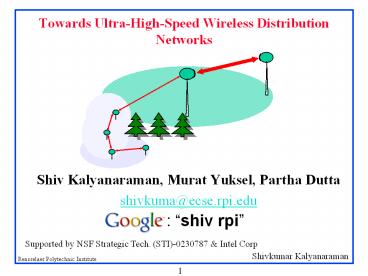Towards%20Ultra-High-Speed%20Wireless%20Distribution%20Networks - PowerPoint PPT Presentation
Title:
Towards%20Ultra-High-Speed%20Wireless%20Distribution%20Networks
Description:
Towards Ultra-High-Speed Wireless Distribution Networks Shiv Kalyanaraman, Murat Yuksel, Partha Dutta shivkuma_at_ecse.rpi.edu: shiv rpi Supported by NSF Strategic ... – PowerPoint PPT presentation
Number of Views:103
Avg rating:3.0/5.0
Title: Towards%20Ultra-High-Speed%20Wireless%20Distribution%20Networks
1
Towards Ultra-High-Speed Wireless Distribution
Networks
- Shiv Kalyanaraman, Murat Yuksel, Partha Dutta
- shivkuma_at_ecse.rpi.edu
shiv rpi
Supported by NSF Strategic Tech. (STI)-0230787
Intel Corp
2
Why not have a Moores law equivalent for
Residential Internet Access?
- Problems today
- FTTH is expensive (100B), but game is changing
- Last-mile telecommunications has a duopoly
structure
3
The Ultra-Broadband Opportunity
- Optical networking slowly closing in on the last
10 miles - Copper and Cable networks still dominate final
mile - Wireless is slowly creeping in as a complementary
technology - 3G Mobility, WiFi hot-spots, WiFi LANs
- WiMax will open the era of broadband wireless
access (true competitor to DSL, cable modems) - Community wireless networks (CWNs) under
experimentation auto-configured, auto-managed
networks - The problem of cheap wireless 1-10
Gbps-to-the-home via wireless technologies is a
good stretch target for the next 10 years
4
Ultra-BB Wireless Prognosis made in 1996!
- Tim Shepard (MIT) Thesis, and SIGCOMM96 paper
- We show that with a modest fraction of the
radio spectrum pessimistic assumptions about
propagation resulting in maximum possible
self-interference and an optimistic view of
future signal processing capabilities that a
self-organizing packet radio network may scale to
millions of stations within a metro area with raw
per-station rates in the hundreds of megabits per
second - Why has wireless ultra-broadband not happened
yet? - Need cheap, open wireless MAN technology building
blocks - Physical layer innovations (MIMO, OFDM)
integrated into open standards - Multi-hop meshes still cannot compete with the
cellular model - Need to allow it to truly self-manage (largely!)
and scale organically.
5
Community Wireless Networks (CWNs)
RPI, Troy, NY
6
Broadband exists. Why CWN?
- Ans Multiplicity.
- Cable modem and DSL and CWN and
- Commodity gt cheap to get multiple access
facilities
USB/802.11a/b
Phone modem
802.11a
Firewire/802.11a/b
WiFi (802.11b)
Ethernet
7
Multipath P2P Video/Data Over CWNs
Traffic engineering Transport level upgrades
8
Mixed Model Infrastructure Wireless/Wired
Networks Coexisting with Multi-Hop Ad Hoc
Wireless Access
WiMax
Mesh Network Goals Ultra high-speeds, Low-costs,
Organic, Self-Managed, Complements Wired
9
Bringing Optical Communications and Ad Hoc
Networking Together
10
Current Commercial FSO
Point-to-Point Links in dense metros, competing
with wires and leased lines Issue How to
achieve link reliability/availability despite
weather
11
Ad-Hoc/Meshed Optical Wireless Why?
- Positive points
- High-brightness LEDs (HBLEDs) are very low cost
and highly reliable components - 35-65 cents a piece, and 2-5 per transreceiver
package upto 10 years lifetime - Very low power consumption (100 microwatts for
10-100 Mbps!) - Even lower power for 1-10 Mbps
- 4-5 orders of magnitude improvement in energy/bit
compared to RF - Directional gt Huge spatial reuse gt multiple
parallel channels for huge bandwidth increases
due to spectral efficiency - More Secure Highly directional small size
weight gt low probability of interception (LPI) - Issues
- Need line-of-sight (LOS) and alignment of LOS
network auto-configuration - Need to deal with weather temporary obstacles,
alignment loss
Challenge leverage huge benefits while tackling
problems.
12
Optical Wireless Commodity components
LEDs
VCSELs
IrDAs
Lasers
Many FSO components are very low cost and
available for mass production.
13
Spatial Re-use 2D FSO Arrays 1-100Gbps Backhaul
- 1cm2 LED/PIN gt 1000 pairs in 1ft x 1ft square
structure - 100 Gbps aggregate bandwidth ( 1000 x 100 Mbps)
14
Auto-Alignment 3D Spherical FSO Structures
15
Initial Ad-Hoc FSO Prototypes
16
Initial Ad-Hoc FSO Prototypes (contd)
Received Light Intensity from the moving train.
Misaligned
Aligned
- Very dense packaging and high mobility are
feasible.
17
Initial FSO Prototypes
Inside of the sphere is coated w/ mirror
Photo-detector
Integrating ball to increase angle of reception
inside is coated with mirror.
18
Audio Transmission on FSO Link using low cost
LEDs and Photo Diodes Two Channel Mixing
a) Two transmitters on different channels
b) Single receiver and circuit for both the
channels
Indoor FSO ad-hoc networks
19
Indoor Ad-Hoc FSO Music App (contd)
20
Hybrids 3D Auto-Alignment with 2D Arrays
21
Auto-configuration Location tracking and
management
- Location tracking (optional integration w/ GPS)
- Use highly granular spherical FSO antennas (e.g.
hundreds of transceivers) ? can detect angle of
arrival - Use time of flight or signal strength ? can
detect distance - Unlike RF, no need for triangulation sense of
direction is available. - Allows easy integration with Community Wireless
Networks (CWNs) - Organic network growth
22
Other Apps Broadband Sensor Networks Eg
Camera Networks
- More than 10,000 public and private cameras in
Manhattan, 2.5 million in the UK! - Subways, airports, battlefields, factory
floors, highways
- Thousands of un-supervised and moving cameras w/o
centralized processing or control - Key Mix of Low Power AND High Speed AND
Ad-Hoc/Unsupervised
23
SUMMARY Ultra-Broadband Wireless puzzle falling
in place
- (1) Infinite Spectrum in Thin Air!
- Key use unlicensed spectrum or larger licensed
bands - (2) Multi-hop architecture w/ Base-Station
Interfaces - Wireless is fundamentally cheap for shorter
distances, smaller coverage - Organic architecture auto-conf, self-management
(10 years of research in ad-hoc networks),
community wireless - IP/geographic routing, fully distributed traffic
engineering mechanisms - Technology neutral, extensible, modular 802.11x,
802.16x, FSO - (2a) Multi-hop Free-space-optics (FSO) using
ultra-low-cost components for 100 Gbps
capabilities - Key Broadband CWNs ad-hoc FSO complementary to
ongoing advances in FTTH, DSL/Cable, WiMax, 3G
rollouts. - Open Problems in upgrading the network and
transport layers to leverage raw, but distributed
bandwidth, and tolerate higher bursty losses
(weather related)
24
Thanks!
Student Heroes Jayasri Akella,
sri_at_networks.ecse.rpi.edu Dr. Murat Yuksel
(post-doc) yuksem_at_ecse.rpi.edu Chang Liu,
c.liu_at_ee.unimelb.edu.au David Partyka,
partyd_at_rpi.edu Sujatha Sridharan Bow-Nan Cheng
chengb_at_rpi.edu (CWN project)
shiv rpi
25
Free-Space-Optical (FSO) Ad-Hoc Networks Mobile
or Fixed Multi-Hop
Application Mixed RF/FSO Ad-Hoc Networks
(Military Application)
26
Aggregate Capacity in 2-d Arrays Interference vs
Density vs Distance
Interference Error vs. Packaging Density
- Bandwidth-Volume Product































